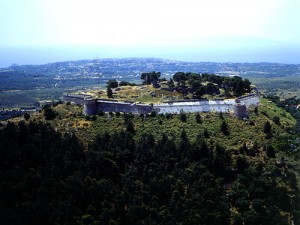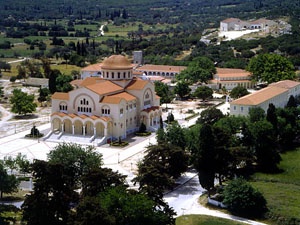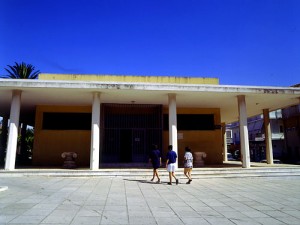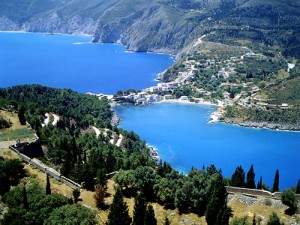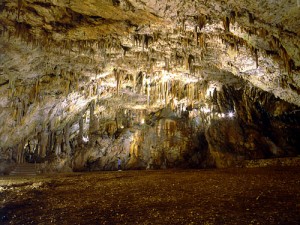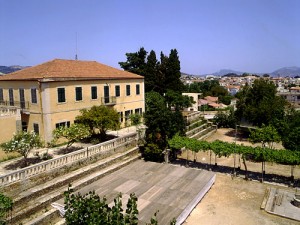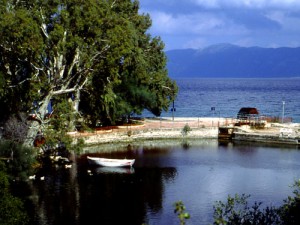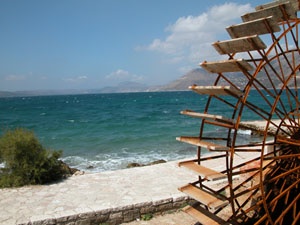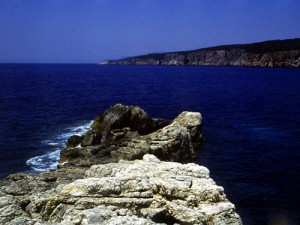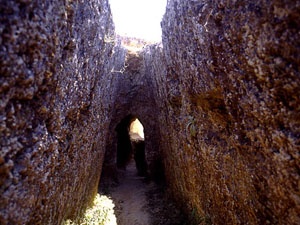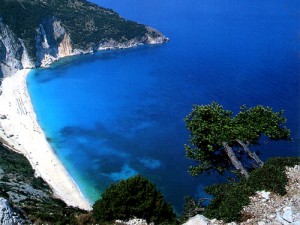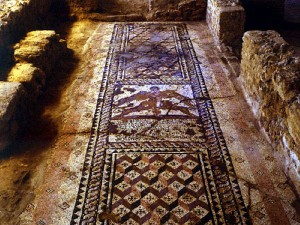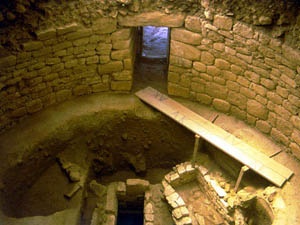AGIOS GEORGIOS CASTLEThe medieval castle of Agios Georgios is situated near the village of Peratata, on a 320 m. high hill. The castle was built in the 13th century to fortify the island’s old capital which was housed here until 1757 AD. The castle owes its name to the large church of Agios Georgios, which is situated in the region and is celebrated glamorously. The castle, along with the island, fell in succession into the hands of the Byzantines, the Franks, the Turks and |
|
| the Venetians. On 24 December 1500, after a persistent battle with the Venetians, the Spanish and the people of Kefalonia, the castle was liberated from the Turks. The severe damage to the buildings led to a restoration supervised by the mechanic Tsimaras, which lasted for four years. Until the earthquake in 1636, the castle thrived and housed storage rooms, a hospital, barracks, private residencies and a prison in which the more liberal people of Kefalonia were kept, whom the current conquerors considered dangerous. The Castle’s entire surface area is 16,000 square metres, and the walls are 600 m. long and 1,015 m. high. The three ramparts face Argostoli, the East and Peratata, respectively. The Castle also includes loopholes, observatories and cannon positions. Inside the Castle, one can admire the tower called “Old Fortress”, as well as part of the walls, underground arches, the throne of the Venetian Lord and a catholic church, where the nobles of Kefalonia were buried. |
|
AGIOS GERASIMOS MONASTERYAgios Gerasimos is the patron saint of the island. On its feast day, the monastery is swarming with pilgrims. According to tradition, he was born in Trikala of Korinthia and was a member of the famous Notaras family. He became a monk and spent twelve years in the Holy Land and five years in Zakynthos. He came to Kefalonia in 1560 and stayed in the cave of the same name, south of Argostoli. |
|
| Later, he founded the monastery and took residence there until his death on 15 August, 1579. Two years later, on 20 October, 1581, his relics were placed inside the monastery. He was canonized in 1622. At the courtyard, there is a big plane tree and a well, which is said to have been dug by the saint himself. Inside, there is a trap-door where he is said to have spent the greater part of his life. On the 15th of August and the 20th of October, big festivals and processions take place. Many miracles are connected to the saint’s relics and icon. | |
ARCHAEOLOGICAL MUSEUMIn the chambers of the Archaeological Museum of Argostoli, one can admire findings during excavations on the island. Some of the exhibits are the findings from the Mycenean Tumbs of Mazarakata and Metaxata, sculpts, pots from the prehistoric and the post-mycenean era, tombstones, coins, seals, small objects and copper weapons. |
|
| The exhibits are dated back to geometric and the ancient era, the classical period, the hellenistic, the roman period and the byzantine era. The most significant of the exhibits are a bronze head of the 3rd century BC and the sign “Tripis Damatri Ke Kora ” of the 6th – 7th century BC, dedicated to goddess Demetter and her daughter Persephone. The sign was found in the location of ancient Krani. | |
ASSOS CASTLEThe castle (Kastro) of Assos, the focal point of Assos’s peninsula, was built by the Venetians in the late 16th century in order to protect the city from pirate raids. Today, one can still admire part of the walls and the arched entrance gate. In the Castle, one can see the ruins of the Venetian High Commissioner’s house, the barracks and the church of Agios Markos. |
|
| From here, the view of the sea and the lovely bay of Mirtos is so unique it attracts many tourists. | |
BEACON OF AGIOI THEODORIThe beacon is situated in Fanari, near Argostoli. It was built in 1820, styled after an English design. During an earthquake in 1953, it was at once destroyed , but it has been restored to its original state. |
|
|
|
|
DROGORATI CAVEDrogorati cave stands a few kilometres outside the town of Sami. It is 45 metres in width, 21 metres in depth, and 9 metres in length. It consists of two parts. The upper part has collapsed and only huge stalactites of different colours remain. The second part is the cave proper (65 x 45 m), which is accessible to tourists and houses cultural events. |
|
| It has extraordinary acoustics, thus its name: “Hall of Apotheosis”. The cave can accommodate about 500 viewers. The regulated lighting in combination with the multi-coloured stalactites creates a picture of unique beauty. | |
IAKOVATIOS LIBRARYIakovatios Library is situated in Lixouri, housed in the beautiful mansion of Iakovati after whom it was named. The majority of the chambers’ walls are beautifully decorated, depicting the family’s previous glamour. Among the 20,000 volumes in the Library, there are 7,000 volumes from the valuable archives of the Iakovati family and 5,000 volumes which belonged to the Professor of Theology, Mr. Alivizatos. |
|
| The most valuable book of the collection is “The Complete Works of Hippocrates”, published in 1595. In a special chamber in the Library, one can admire a small collection of icons and other ecclesiastic heirlooms of the 10th and 15th century, the most significant of which are the icons of “The Miracle at Hones” by Michael Damaskinos and “The Assembly of the Michaelmas” created by the monk Filotheos Skoufos. | |
KARAVOMILOSThe area of Karavomilos is situated northwest of Sami. After an investigation conducted by Yannis Petrohilos and, in 1963, from the Austrian scientists Zolt and Maurin, it was discovered that the waters, which one loses track of in Katavothres, flow into the village of Karavomilos by underground rivers every 15 days. Thus, a small salt-water lake has been created here. This unique phenomenon attracts many tourists to the area. |
|
|
|
|
KATAVOTHRESKatavothres, situated 3 km outside Argostoli in the area of Fanari, constitute a peculiar geological phenomenon. At first it was observed that the water from the sea went into the ground through holes and then it disappeared. After a thorough investigation, initially performed by Ioannis Petrohilos and in 1963 by the Austrian scientists Zolt and Maurin, it was discovered that the water, through underground rivers, flooded in the village of |
|
| Karavomilos, in the east, 15 km away and in the spring Fridi at Agia Eyfimia, after approximately 15 days. In this area, in the early 20th century, there was a hydroelectric factory and ice factory, for the exploitation of the underground water. | |
KORGIALENIO HISTORICAL AND FOLK MUSEUMKorgialenio Historical and Folk Museum is situated in the center of Argostoli. It was established in 1966, in an area of 300 sq. m. The Museum exhibits the local costumes, furniture and embroidery of Kefalonia. Other exhibits includes heirlooms and other ecclesiastic items, pictures, paintings, maps, manuscripts, coins, jewels, silver and metal craftworks and much more. |
|
| In a special chamber in the museum’s basement, the Historical Archives of Kefalonia display historical manuscripts from the 16th-19th centuries, depicting several historical periods. The building also houses the Library of the same name. | |
KORGIALENIOS LIBRARYThe Korgialenios library is housed in the museum of the same name, in Argostoli. It was founded in 1924 with money donated from Marinos Korgialenios, after whom the library was named. Although it suffered from the earthquake of 1953, the library was restored. Today, it is open to the public. It holds 46,000 volumes and many significant cultural events take place here every year. |
|
|
|
|
KOUNOPETRAKounopetra is situated 9 km south of Lixouri. The location’s visitor comes across a very significant geological phenomenon. To be more specific, from the sea emerges a huge rock which, before the earthquake in 1953, used to move constantly and rhythmically. After the earthquake the rock’s base was relocated and the rock stabilized to its current place. Tradition claims that English ships tied Kounopetra with thick ropes and chains and attempted unsuccessfully to remove it. |
|
| MYCENEAN TOMBS – MAZARAKATA Significant tombs that testify the existence of an important Mycenean settlement. The findings from the excavations include Mycenean art jewelry. |
|
|
|
|
MELISSANI CAVEThe cave of Melissani, outside Sami, is one of the most significant sights on the island. As the excavations of 1963 have shown, it has taken its name from the nymph Melissanthi. These excavations brought to light aspects of the nymph, a statuette, and an earthen tray with a depiction of Pan. In 1951, an ancient lamp, which is now on display in the Archaeological Museum of Argostoli, was also found there. |
|
| The cave is 40 metres in width, 36 metres in height, and 3.5 metres in length. Inside, it is covered by water 20 to 30 meters in depth due to the collapse of a part of the roof. Small crafts carry visitors there to admire the spectacular sight of the stalactites and the changing colours of the water. An artificial balcony offers an enchanting view from the top of the cave. | |
MYRTOSUndisputably,one of the most beautiful beaches in greece and one of the world’s best. The white shore meets the blue of the sea which is present in every possible shade. The view from the stopover on the road high above Myrtos, is simply unmatched. |
|
ROMAN VILLA – SKALAwell preserved mosaics and designs, dating to the 3rd century AD, in the ruins of a roman villa discovered in excavations carried out in the area of Skala. |
|
|
|
|
TZANNATA-VAULTED TOMBThe excavation in this area brought to the surface the largest vaulted tomb ever found in western Greece. The unique findings, which include jewelry and a seal, prove that the existence of a significant Mycenean center |
 English
English  Ελληνικα
Ελληνικα 

